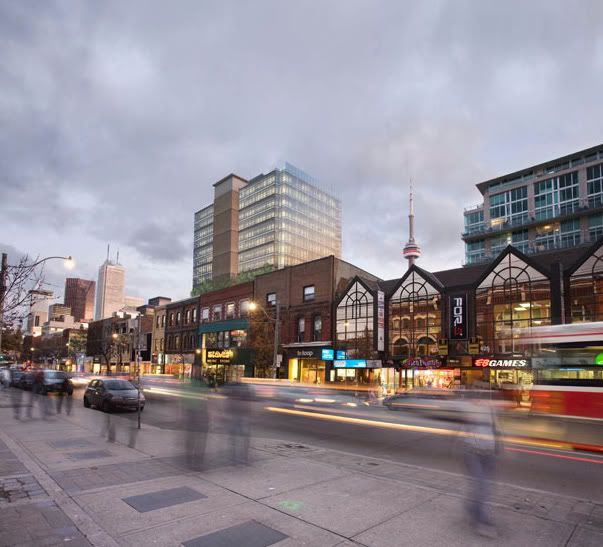Just to keep the dialogue going...
For me, this is a good example of the Toronto Style as defined by a philosophy of regional or local contextuality.
This project defines some major features of design in Toronto:
- A valuing of local context which in this case translates to the heritage structures and streetscapes, their scale and how they meet the street in a way that encourages vitality. This informs a sensibility that tips the scale in favour of retaining the original buildings, even where other options would be less complicated and less expensive.
- Faced with the mandate to preserve the buildings a fundamental part of the design is how the new structure will integrate with the original ones. Light and glassy minimalist modernism provides a nice counterpoint to the red-brick heritage materials, the addition nicely contrasting and complimenting the original buildings and vice versa. In this sense the sensitivity to context actually informs the design.
- This design response has further significance in a wider city context by addressing the height and density issues of typically low-rise streetscapes surrounding the downtown core without compromising the valued heritage roots mentioned above. This building design response then is also informing urban development. It is a design response that is literally rebuilding vast swaths of the city, emerging where possible along already established streetscapes everywhere here, new in-fill projects also taking their cue from it, mixing new brick bases aligned with heritage streetscapes with point towers or multi-storey glass elements that increase height and density. The examples are everywhere from Jazz on Church to the Distillery to Yorkville to all along Queen and King Streets.
This picture illustrates the impact of this Toronto Style in terms of the direction of urban development in established areas. Here we see an emerging streetscape of new development integrating contextually with the existing built form to create a new city of increased height and density.
All things considered this design response is informing development in a way that City Place or the development of new tracts south of the rails doesn't. It is a more Jacobs-inspired organic evolution of the built form of the city that feels contextual to Toronto, which is not to claim that this type of response is not seen elsewhere but the issue is to what degree? In Toronto it is transformative, defining city development to a degree that is not the case elsewhere.
If looking for an elusive Toronto style doesn't this have more meaning than looking for some theoretical aesthetic novelty to emerge that will come to define Toronto and capture the imagination of the world? At the end of the day people will come to this city and will get an overwhelming impression of how Toronto is developing in the critical mass of its buildings and along its streets that
will make the city unique in their eyes.















